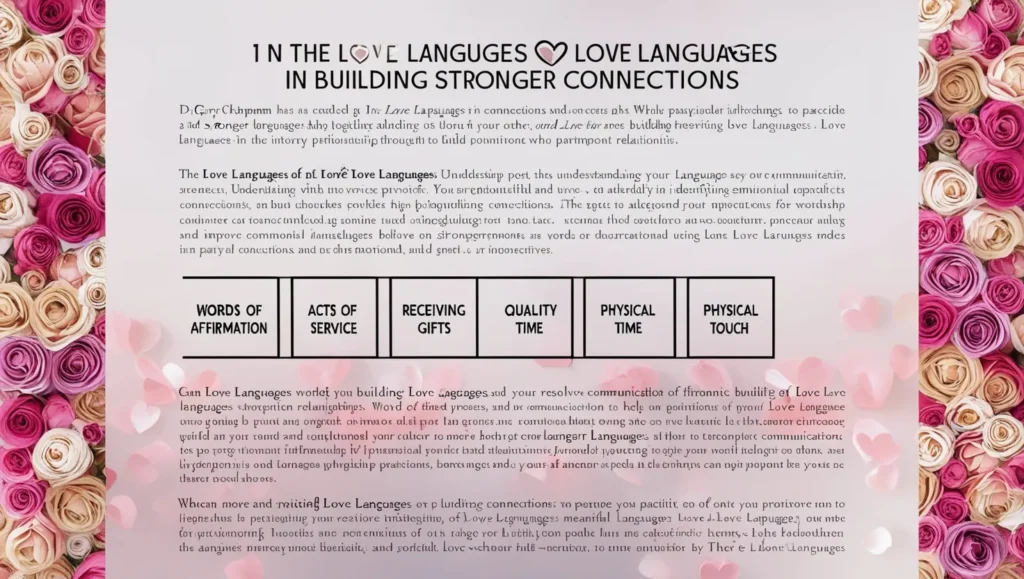The Role of Love Languages in Building Stronger Connections
Human connections thrive on understanding, care, and communication. One of the most impactful ways to enhance relationships is by understanding the concept of love languages. Introduced by Dr. Gary Chapman in his book The Five Love Languages, these languages explain how people express and receive love. Knowing your love language—and that of your partner, friends, or family—can help deepen bonds, resolve conflicts, and create lasting connections.
What Are Love Languages?
Love languages describe the different ways people feel and express affection. Dr. Chapman identified five primary love languages:
- Words of Affirmation
Expressing love through verbal encouragement, compliments, and kind words.- Example: Saying “I appreciate you” or “You mean so much to me.”
- Acts of Service
Demonstrating love through helpful actions and gestures.- Example: Cooking a meal, running errands, or fixing something without being asked.
- Receiving Gifts
Showing love through thoughtful presents that reflect care and attention.- Example: Giving a handmade card, flowers, or a surprise gift.
- Quality Time
Focusing on undivided attention and meaningful interactions.- Example: Going on a date, having deep conversations, or enjoying hobbies together.
- Physical Touch
Conveying love through physical closeness and contact.- Example: Holding hands, hugs, or a reassuring pat on the back.
How Love Languages Strengthen Connections
Improved Communication
Understanding someone’s love language allows you to communicate affection in a way they truly resonate with. For instance, a partner who values acts of service might feel more loved when you help with chores rather than giving verbal praise.
Conflict Resolution
Misunderstandings often arise when individuals express love in their own language rather than the recipient’s. Recognizing these differences helps reduce frustration and builds empathy during disagreements.
Deeper Emotional Bonds
Tailoring your gestures of love strengthens trust and intimacy. A friend who cherishes quality time will feel closer when you prioritize spending time together.
Personal Growth
Learning to express love in different languages expands your emotional repertoire and makes you more attuned to others’ needs.
Identifying Your Love Language
- Self-Reflection
Consider how you naturally express love and what makes you feel most appreciated. Do you value compliments, shared moments, or small surprises? - Take the Love Language Quiz
Dr. Chapman’s official quiz provides a structured way to identify your primary love language. - Observe Your Reactions
Notice how you respond to different expressions of affection. Are you happiest when someone helps you, gives you a thoughtful gift, or spends time with you?
Adapting to Others’ Love Languages
- Ask and Observe
Communicate openly with loved ones about their love language. Pay attention to their reactions and preferences. - Make a Conscious Effort
If your love language differs from theirs, practice showing love in their preferred way, even if it feels unfamiliar initially. - Balance Your Expression
While focusing on their love language, don’t neglect your own needs. Share your love language to ensure mutual understanding.
Examples of Love Languages in Different Relationships
Romantic Relationships
- Words of Affirmation: Leaving a sweet note or texting compliments during the day.
- Acts of Service: Doing household chores to lighten your partner’s load.
Friendships
- Quality Time: Planning regular catch-ups or video calls.
- Receiving Gifts: Remembering their favorite snack or giving a birthday present.
Parent-Child Relationships
- Physical Touch: Giving comforting hugs or high-fives.
- Words of Affirmation: Praising their efforts and achievements.
Workplace Relationships
- Acts of Service: Helping a colleague meet a deadline.
- Words of Affirmation: Recognizing their hard work and contributions.
Common Challenges and How to Overcome Them
- Misaligned Love Languages
- Solution: Be patient and open to compromise. Focus on small, consistent gestures that align with their language.
- Unfamiliarity with a Love Language
- Solution: Practice and seek guidance. If you struggle with expressing love through gifts, start small with thoughtful tokens.
- Neglecting Your Own Needs
- Solution: Communicate your love language to others and explain how they can support you.
Why Love Languages Matter in Modern Relationships
In a world filled with distractions and busy schedules, understanding love languages offers a roadmap for genuine connection. Whether it’s with a partner, friend, or family member, speaking their love language shows intentionality and care, fostering meaningful relationships in every area of life.
Final Thoughts
The concept of love languages is a powerful tool for building stronger connections. By learning and applying these principles, you can create deeper, more fulfilling relationships. Start today by discovering your own love language and exploring those of your loved ones. Together, you can bridge gaps in communication and nurture bonds that stand the test of time.
Would you like to explore your love language or need help implementing these ideas in your relationships? Let me know!

